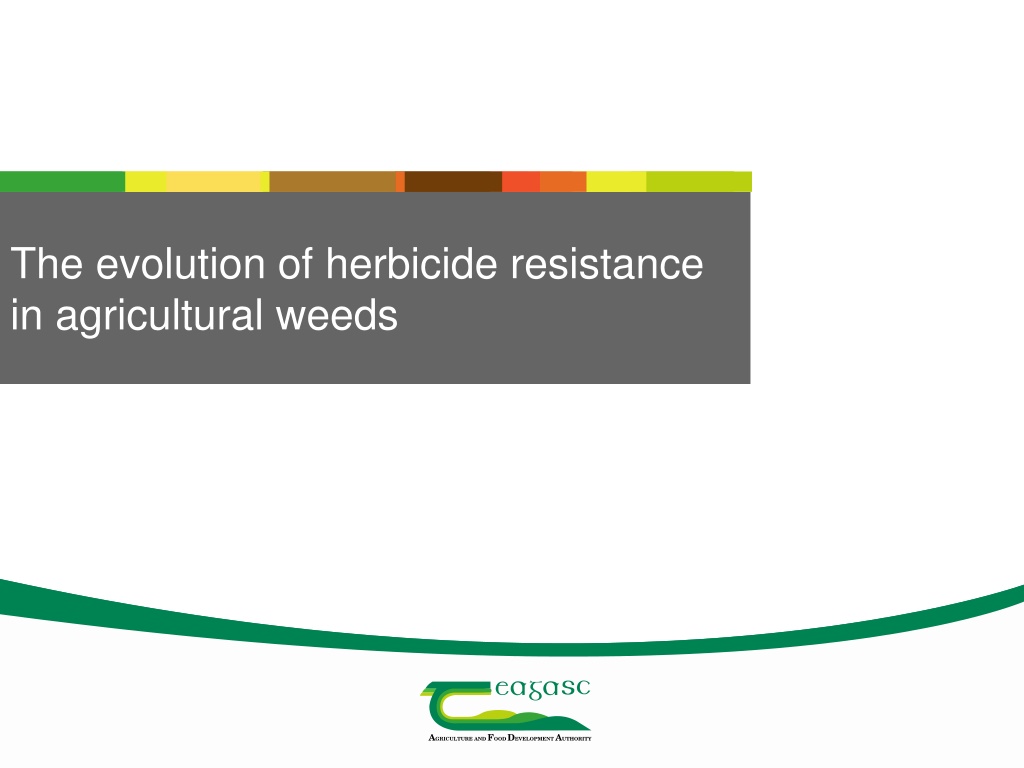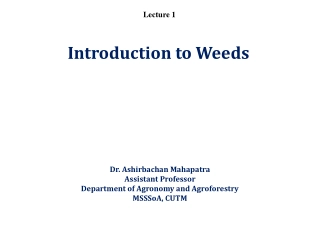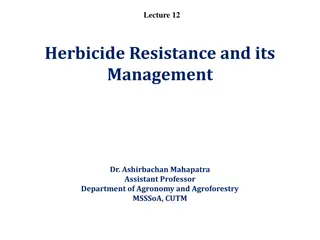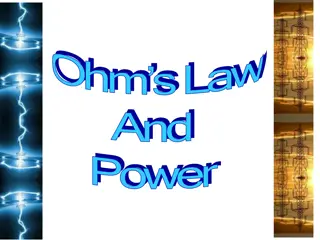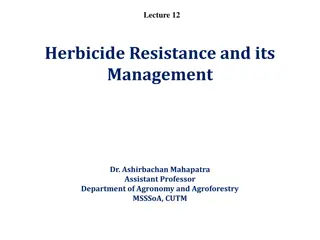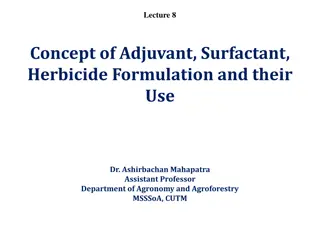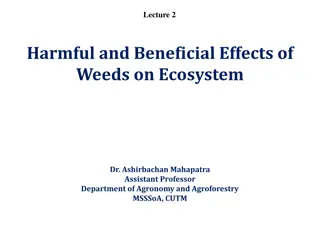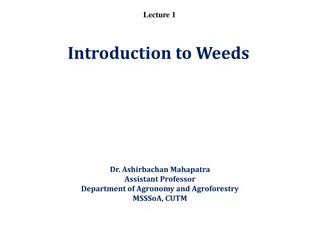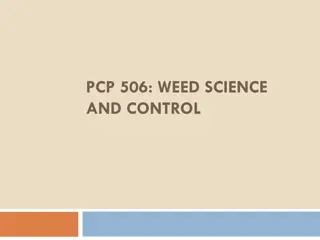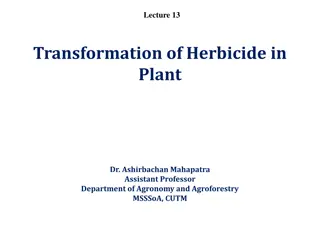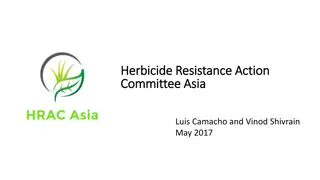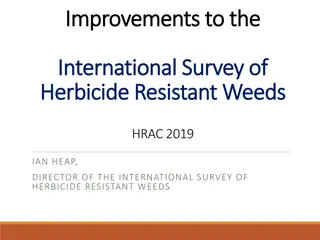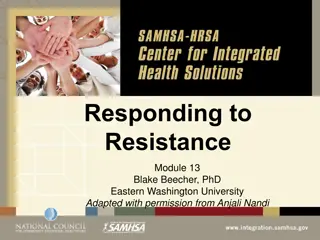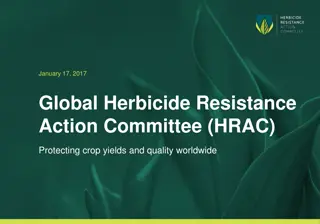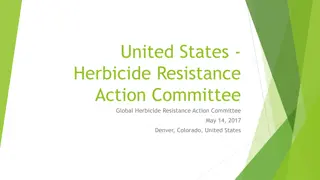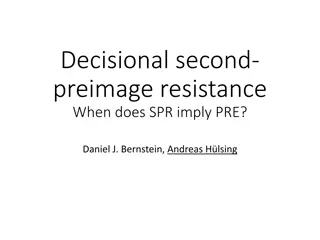Understanding Herbicide Resistance in Agricultural Weeds
This comprehensive content covers the evolution of herbicide resistance in agricultural weeds, including the origins of herbicides, cases of resistance, target site resistance, and non-target site resistance. It explains the definition of weeds, types of herbicides, selective and non-selective herbicides, and examples like Acetyl CoA carboxylase inhibitors and Glyphosate. Additionally, it delves into early herbicide research during World War II and the development of 2,4-D herbicide.
- Herbicide resistance
- Agricultural weeds
- Selective herbicides
- Non-selective herbicides
- Herbicide research.
Download Presentation

Please find below an Image/Link to download the presentation.
The content on the website is provided AS IS for your information and personal use only. It may not be sold, licensed, or shared on other websites without obtaining consent from the author. Download presentation by click this link. If you encounter any issues during the download, it is possible that the publisher has removed the file from their server.
E N D
Presentation Transcript
The evolution of herbicide resistance in agricultural weeds
Lecture outline Origins of herbicides First cases of herbicide resistance Target site resistance Non target site resistance Irish weed research 2
What is a weed? Any plant growing where it is unwanted in competition with a cultivated species 3
Herbicides A substance used to kill vegetation. Two main types Selective herbicides kill specific plants (typically weeds) but do not kill others (typically the crop). Non-selective herbicides kill all vegetation they are applied to. 4
Selective herbicides: an example Acetyl CoA carboxylase inhibitors (ACCase) inhibitors. Prokaryotic and eukaryotic ACCase. Eukaryotic ACCase is sensitive to ACCase inhibiting herbicides. Plastidic and cytosolic ACCase. Monocots have plastidic and cytosolic eukaryotic ACCase. Dicots, on the other hand, have only cytosolic eukaryotic ACCase. ACCase inhibiting herbicides target plastidic ACCase. Thus, only monocots are killed, with dicots unaffected. 3 main families of ACCase inhibitors: dims , fops and dens 5
Non-selective herbicides: an example 5-enolpyruvylshikimate-3-phosphate synthase (EPSPS) inhibitors. AKA Glyphosate AKA Roundup EPSPS is an important part of the shikimate pathway which produces many aromatic products such as lignins, alkaloids, flavonoids, benzoic acids, and plant hormones, in addition to amino acids needed for protein synthesis. This makes glyphosate such a useful herbicide! Save questions about how much I m being paid by Monsanto for the end please. 6
Early herbicide research Commercial herbicides were developed during World War II. 2,4-D, the first herbicide came from research investigating the role of IAA in plant growth regulation. Researchers found that high doses of IAA would kill dicots, however IAA was too unstable to be used effectively. 2,4-D is essentially a synthetic auxin. Rapidly increased farm efficiency, effectively replaced the hoe Kept secret because initial plans were to use herbicides to destroy German crops to help starve the war effort. Never materialised, but tactic was eventually used by the US army during the Vietnam War, which was very sound of them. 7
Early herbicide research Commercial herbicides were developed during World War II. 2,4-D, the first herbicide came from research investigating the role of IAA in plant growth regulation. Researchers found that high doses of IAA would kill dicots, through uncontrollable cell division in meristematic zones. However IAA was too unstable to be used effectively. 2,4-D is essentially a synthetic auxin. Rapidly increased farm efficiency, effectively replaced the hoe Kept secret because initial plans were to use herbicides to destroy German crops to help starve the war effort. Never materialised, but tactic was eventually used by the US army during the Vietnam War, which was very sound of them. 8
Global herbicide resistance First cases of herbicide resistance were reported in the US in the 50s, shortly after the introduction of commercial herbicides. Resistance has been increasing steadily since Resistance events were typically met with chemical solutions ie. new herbicide modes of action, But no new MOAs have been released in over 20 years 9
Global herbicide resistance Why was Ireland so late to resistance? 10
Global herbicide resistance Why was Ireland so late to resistance? Ireland has one of the best climates in the world to produce cereals in. We have very vigorous, competitive crops resulting in these high yields 11
Global herbicide resistance Why was Ireland so late to resistance? It s also entirely likely that herbicide resistance has been an issue under the surface in Ireland for a number of years 12
Herbicide resistance in Ireland Long suspected but only confirmed for the first time in 2016. Species: Wild oats (ACCase + ALS) Sterile brome (ALS) Great brome (ALS) Black grass (ACCase + ALS) Suspected species: Annual meadowgrass Italian ryegrass 13
Proximal versus distal causes Proximal causes are events that are the closest to, or immediately cause the observed effect. Distal causes are thought of as the ultimate reason the observed effect happened, only chronologically further from said event. Why do we care? 14
Proximal versus distal causes: an example The Golden State Warriors won the 2018 NBA championships. The proximal cause of this event was GSW winning game 4 of the finals vs Cleveland, 108-85 15
Distal causes of GSW winning the 2018 NBA championships. The NBA salary cap spiked in the summer of 2016, facilitating GSW to sign Kevin Durant. The early portion of Stephen Curry s career was plagued with ankle injuries, meaning the team was able to sign him on a contract for less than what he was worth. A combination of rule changes during the 2000s and advancements in the statistical analysis of basketball lead to three point shooting and floor spacing being of the utmost importance in the modern game. 16
Proximal causes of herbicide resistance Target site point mutations. Non target site resistance. More on these later! 17
Distal causes of herbicide resistance. Lack of crop diversity. Narrow range of herbicide active ingredients. Poor grain prices. Lack of knowledge (weed identification). Over-reliance on commercial agronomists. The list goes on! 18
A basic model for target site resistance A point mutation, typically in part of the gene that codes for the binding site of the herbicide. Stops the herbicide from binding. Doesn t affect the normal function of the protein. Plant can reproduce post- spray application. Resistance allele becomes more frequent in population. 19
Target site resistance: ACC1 I1781L point mutation Acetyl CoA carboxylase ACCase is required in plants for fatty acid synthesis. Under normal circumstances, carboxylated biotin translocates to the carboxylase transferase CT active site. Here, the carboxylase group is transferred to the acetyl CoA substrate. This leads to the formation of malonyl CoA. ACCase inhibiting herbicides bind to this CT domain, stopping this transfer. 20
Target site resistance: ACC1 I1781L point mutation The isoleucine 1781 residue is an important part of this binding point. The I 1781 L substitution changes the conformation of the ACCase protein such that ACCase herbicides can no longer bind, but the protein can still bind to its substrate. This point mutation occurs in an area of the CT domain involved in the binding of the three families of ACCase inhibitors. Can cause cross-resistance to all three! 21 Vila-Aiub et al., 2015
Non target site resistance Plants within populations vary with respect to their resistance to herbicides based on standing genetic variation. Consider herbicide application as a form of abiotic stress. Consistent herbicide application selects for alleles that contribute to resistance, no matter how small the contribution to overall resistance. This leads to an accumulation of minor resistance-endowing alleles 22
Non target site resistance Cytochrome P450 monooxygenases are a major gene superfamily involved in abiotic stress tolerance. Increased CYP450 activity allows plants an increased ability to metabolise herbicides. This can confer broad spectrum resistance to a range of herbicides, even to active ingredients that haven t been developed yet! One way CYPs can be implicated in resistance is to inhibit their function and look at the effects on resistance 23
Resistance by increased gene expression In wild type plants (A) normal doses of glyphosate are sufficient to inhibit EPSPS and kill treated plants. Resistant plants (B) produce sufficient EPSPS to continue to operate the shikimate pathway despite application of glyphosate. This can be achieved through increased EPSPS copy number, or increased gene expression. Glyphosate, and all herbicides can only be applied legally at certain doses. Furthermore, herbicides have an economic threshold! 24
Irish herbicide resistance research ACCase cross resistance in Irish wild oats. Distribution and frequency of resistance in Co. Wexford. Effect of gibberellins on seed dormancy and herbicide resistance. ECT Enable Conservation Tillage 25
Cross resistance in Irish wild oats Three objectives: Determine levels of resistance to propaquizafop and pinoxaden in 4 populations of wild oats. Inhibit CYP450 and GST to understand their involvement in resistance. Sequence ACC1 to relate resistance phenotype to the presence of point mutations in the ACCase CT domain. 26
The distribution and frequency of resistance in Co. Wexford Wexford has the largest area of crops grown of any county in Ireland. Spring barley is a major crop in the area. Spring germinating weeds are an issue. ACCase resistant wild oats are becoming more prevalent. But how prevalent? And why? 27
Effect of gibberellins on dormancy/ resistance. Populations differ in terms of dormancy as well their response to GA3. Dormancy is a complex, multifactorial trait. Imbibing seeds with GA3 increases germination rate and germination percentage. 28 Teagasc Presentation Footer
Future directions Any future interventions will have to mindful of eco-evolutionary implications of their implementation. Integrated weed management HWSC From research side: NTSR How does resistance spread? What other life traits are associated with herbicide resistance and can they be utilised in a weed management strategy? 30
Probably not future directions tbh More herbicides We have already selected for weeds with decreased sensitivity to herbicides for the last 50+ years. If we address this problem solely with herbicides, evolution will win 31
Cheers! Research funded through the Teagasc Walsh Fellowship fund and the Irish seed trade association. 32
